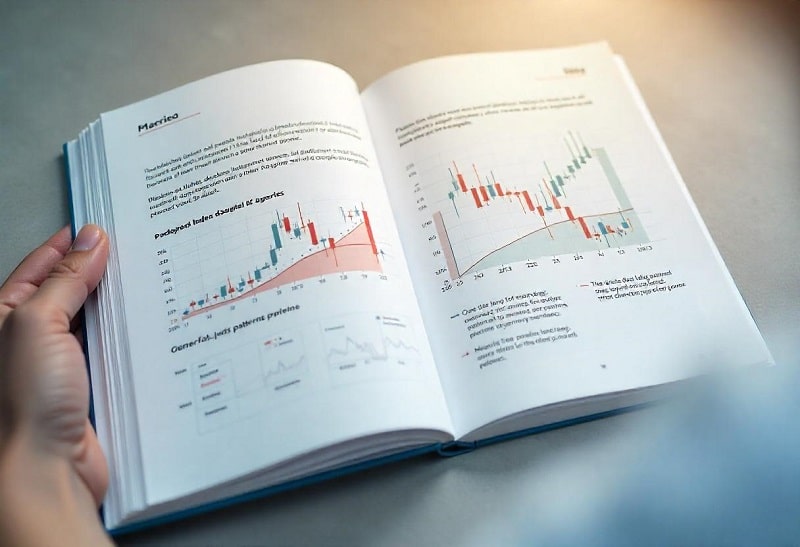The Double Bottom pattern is a fundamental bullish reversal pattern in technical analysis, recognized across global financial markets. It signals a potential end to a downtrend and the start of a new upward price movement. Its significance lies in suggesting waning selling pressure and emerging buying interest, potentially marking a key market low.
Visually resembling the letter “W” on price charts , the pattern features two consecutive troughs at roughly the same price level, separated by an intermediate peak. While the shape is a primary identifier, a thorough analysis requires examining other factors to validate its predictive power.
Applicable across stocks, forex, commodities, and cryptocurrencies on various timeframes , the Double Bottom reflects core market dynamics—the battle between buyers and sellers near perceived value areas. For analysts, it’s a vital tool for identifying potential long entry points, managing risk near support, and gauging shifts from bearish to bullish sentiment.
Anatomy of the Double Bottom: Identifying Key Components
Understanding the pattern’s structure is crucial for accurate identification.
The Preceding Downtrend Requirement
As a reversal pattern, a Double Bottom must follow a prior downtrend. It forms at the bottom of this decline. The reversal’s potential significance often correlates with the preceding downtrend’s duration; patterns after longer declines (ideally several months) are generally considered more potent.
First Trough (First Low)
This initial low point establishes the pattern’s lower boundary and potential support zone. It often represents peak pessimism or seller capitulation. This level becomes critical for the market’s subsequent retest.
Intermediate Peak (Reaction High)
Following the first trough, a reactive rally occurs, typically advancing 10% to 20% from the low. The rally’s highest point forms the “neckline,” an intermediate resistance level. This rally shows initial buying interest but isn’t yet strong enough to overcome the downtrend.
Second Trough (Second Low)
Selling pressure resumes, pushing prices back towards the first trough’s level. Crucially, the second low fails to break significantly below the first, finding support at or very near the same price. This successful test indicates waning selling momentum and increasing buyer assertiveness. Often, trading volume is lower during the decline into the second trough compared to the first, suggesting diminishing selling pressure.
Key Characteristics of the Formation
- Trough Similarity (The 3-4% Rule): The lows should be “roughly equal”. A common guideline allows the second low to be within 3% to 4% of the first low’s price level. A slightly higher second low can be seen as more bullish. The key is the successful defense of a support zone.
- Duration Between Troughs: The time between troughs typically ranges from one to three months. Longer durations (weeks or months) generally yield more reliable patterns, indicating more significant reversals. A minimum separation (e.g., four weeks or 6-10 candlesticks ) is often preferred.
- Shape Variations: The pattern should resemble a “W”. The first trough might be sharper (panic selling), while the second could be more rounded (accumulation). The troughs must be distinct low points.
The Psychology Behind the Pattern: Understanding Market Sentiment Shifts
The Double Bottom visually represents a shift from bearish despair to bullish hope.
From Bearish Exhaustion to Bullish Takeover
The pattern starts within a downtrend. The first trough often marks peak fear or seller capitulation. The subsequent rally to the intermediate peak shows tentative optimism (value buying, short covering) but meets resistance.
The Tug-of-War at Support
The decline to the second trough is the critical test. Bears try to push lower, but fail as the price finds support near the first low. Buyers step in, absorbing selling pressure and defending the level. This successful defense signals a potential power shift.
Volume Clues and Sentiment Confirmation
Volume provides insight into conviction :
- High volume at the first low may confirm capitulation.
- Lower volume on the decline to the second trough suggests drying selling pressure.
- Increasing volume on the rally off the second trough and especially on the neckline breakout signals growing buyer enthusiasm and confirms bullish sentiment.
The “Shake Out” Effect
The pattern formation often “shakes out” less committed traders (“weak hands”). The retest of the lows frightens them into selling, allowing more resolute investors (“strong hands”) to accumulate shares at perceived value.
This transfer strengthens the foundation for a potential uptrend. A pattern failure (breaking below support) signifies buyer failure and often accelerates the downtrend.
Confirmation is Key: Validating the Double Bottom Signal
A “W” shape alone is insufficient; confirmation is needed to validate the reversal signal and reduce the risk of trading false patterns.
The Crucial Neckline Breakout
The most critical confirmation is a decisive breakout above the neckline (the peak resistance between troughs). Until this resistance is overcome, the pattern is only potential. The breakout shows buying pressure has overwhelmed selling pressure at that level.
Volume’s Role in Confirmation
Confirmation is significantly stronger when the breakout occurs on increased trading volume. High volume indicates strong participation and conviction behind the move, suggesting sustainability. Breakouts on low volume are suspect and prone to failure (“false breakouts”). Increasing volume during the advance from the second trough towards the neckline also signals growing bullish momentum.
Price Action Confirmation
A decisive close above the neckline (e.g., on a daily chart) is generally required. Intraday piercings may not be sufficient. Additionally, some traders look for a pullback after the breakout where the price retests the former neckline (now potential support) and holds, reinforcing the breakout’s validity.
Trading the Double Bottom: Strategies and Tactics
Once confirmed, traders can employ strategies involving entry points, stop-losses, and profit targets.
Entry Strategies
- Breakout Entry: Enter long upon a decisive close above the neckline, ideally with high volume. Aims to capture initial momentum but risks false breakouts.
- Pullback/Retest Entry: Wait for the breakout, then enter long if the price pulls back to the neckline and finds support. Offers more confirmation and potentially better risk/reward, but risks missing the trade if no pullback occurs.
- Early Entry (Aggressive): Enter near the second low formation. Offers the best potential price but carries high risk as the pattern is unconfirmed.
Placing Effective Stop-Loss Orders
Stop-losses are crucial for risk management. Common placements:
- Slightly below the second trough.
- Below the broken neckline (now support).
- Below the low of the breakout candlestick.
Placement requires balancing avoidance of premature triggers with pattern validity.
Setting Profit Targets (Measured Move Calculation)
Estimate upside targets using the pattern’s height :
- Measure the vertical distance from the lowest trough to the neckline peak.
- Project this distance upward from the neckline breakout point.
- The result is the minimum expected price objective.
This assumes the reversal energy propels the price by a similar magnitude. Aggressive targets might involve projecting twice the height or targeting known resistance levels. Targets are estimates, not guarantees.
Integrating with Other Indicators
Reliability can be enhanced by confirming with other indicators :
- Momentum Oscillators (RSI, MACD): Look for bullish divergence (higher oscillator low vs. equal/lower price low).
- Stochastic Oscillator: Check for oversold readings near troughs.
- Moving Averages/Bollinger Bands: Confirm trend shift post-breakout.
The Double Bottom is not infallible; traders must recognize its limitations and potential failures.
Recognizing False Breakouts (Fakeouts)
A common issue where price breaks the neckline then quickly reverses below it. Often characterized by low volume and lack of follow-through. Mitigation tactics include waiting for a decisive close above the neckline, requiring volume confirmation, or waiting for a pullback/retest entry. Failed breakouts can lead to sharp downward moves.
Reasons for Pattern Failure
Failure occurs when price breaks decisively below trough support. Reasons include:
- Dominant Prevailing Trend: Underlying bearish momentum is too strong.
- Insufficient Buying Power: Lack of volume/conviction prevents follow-through.
- Negative External Factors: News, sentiment shifts, or economic changes overwhelm the technical signal.
- Incorrect Pattern Identification: Misinterpreting price action.
A failed Double Bottom often reinforces the downtrend.
Double Bottom vs. Double Top: A Comparative Analysis
Comparing the Double Bottom with its bearish counterpart, the Double Top, enhances understanding. They are mirror images.
- Double Bottom: Follows downtrend, “W” shape, two troughs (support), signals bullish reversal on break above neckline (resistance).
- Double Top: Follows uptrend, “M” shape, two peaks (resistance), signals bearish reversal on break below neckline (support).
The core concepts (prior trend, key levels, neckline, confirmation break, volume, psychology) apply symmetrically but in opposite directions. A confirmed Double Bottom suggests potential long entries , while a confirmed Double Top suggests potential short entries.
Conclusion: Integrating the Double Bottom into Your Trading Toolkit
The Double Bottom is a significant technical pattern indicating potential market turning points by reflecting shifts in supply and demand near support.
Key Takeaways:
- A classic bullish reversal pattern (“W” shape).
- Forms after a downtrend with two troughs establishing support.
- Neckline (intermediate peak) acts as resistance.
- Confirmation requires a decisive close above the neckline with increased volume.
Core Principles:
- Confirmation over Anticipation: Wait for validation to reduce risk.
- Psychology Matters: Understand the sentiment shift narrative.
- Context is King: Assess reliability based on trend, timeframe, market conditions, and fundamentals.
Primacy of Risk Management: No pattern is foolproof; false signals and failures occur. Diligent risk management via stop-losses and position sizing is essential.
The Double Bottom is a valuable tool, but effective use requires disciplined identification, confirmation, contextual analysis, and risk management. Integrate it within a broader technical framework, using other indicators for confluence. Continuous learning and practice are key.
Frequently Asked Questions (FAQ)
What is a Double Bottom pattern?
The Double Bottom is a bullish reversal chart pattern used in technical analysis that resembles the letter “W”. It forms after a downtrend and consists of two distinct troughs (lows) at roughly the same price level, separated by an intermediate peak (neckline). It suggests a potential end to the downtrend and the beginning of an uptrend.
What does a Double Bottom pattern signal?
It signals a potential bullish reversal, indicating that selling pressure is weakening near a support level and buying interest is increasing. It suggests the downtrend may be ending and an uptrend could begin.
How is a Double Bottom pattern confirmed?
Confirmation requires the price to decisively close above the neckline (the resistance level formed by the peak between the two troughs). This breakout should ideally occur with a significant increase in trading volume.
What’s the difference between a Double Bottom and a Double Top?
They are opposite patterns. A Double Bottom (“W”) forms after a downtrend and signals a potential bullish reversal. A Double Top (“M”) forms after an uptrend and signals a potential bearish reversal.

































